Seven Questions Over Breakfast with Carson Ellis
 May 17th, 2011 by jules
May 17th, 2011 by jules
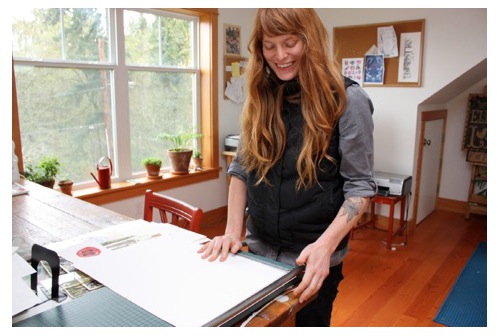
Once upon a time—forty years ago, to be exact—author Florence Parry Heide wrote a story called Dillweed’s Revenge: A Deadly Dose of Magic with the express intent of having Edward Gorey illustrate it. Joining Heide in penning the story was her brother and his wife, visiting from out of town, and her own daughter, Roxy. “Some editors liked the story but wanted a date on which the art would be finished, and Edward Gorey would never work that way. So, it sat and it sat,” said Heide (at the short Q & A at this link).
 Dillweed’s story (a color sketch from the 2010 version is pictured left) is one of, in the words of Heide again, “naughtiness, excitement, and danger.” (Her exact quote, which I love? “Of course kids like to be soothed and reassured and coddled and amused, but they also like to read of naughtiness, excitement, and danger.”) Dillweed uses some magical runes stored under his bed and his bizarre pet (and only friend), Skorped, to get revenge on his lousy, inattentive parents and Umblud and Perfidia, the two hateful servants left in charge of Dillweed, while his parents are off having adventures. It’s a wonderfully warped, dark tale, which I’ve mentally added to this ever-growing list of Slightly Demented Picture Books. Or, if you’re Bob Shea and Lane Smith weighing in on the book: “WHY WE RECOMMEND THIS BOOK: debauchery, black magic, murder and inspired shenanigans throughout.”
Dillweed’s story (a color sketch from the 2010 version is pictured left) is one of, in the words of Heide again, “naughtiness, excitement, and danger.” (Her exact quote, which I love? “Of course kids like to be soothed and reassured and coddled and amused, but they also like to read of naughtiness, excitement, and danger.”) Dillweed uses some magical runes stored under his bed and his bizarre pet (and only friend), Skorped, to get revenge on his lousy, inattentive parents and Umblud and Perfidia, the two hateful servants left in charge of Dillweed, while his parents are off having adventures. It’s a wonderfully warped, dark tale, which I’ve mentally added to this ever-growing list of Slightly Demented Picture Books. Or, if you’re Bob Shea and Lane Smith weighing in on the book: “WHY WE RECOMMEND THIS BOOK: debauchery, black magic, murder and inspired shenanigans throughout.”
According to illustrator Carson Ellis—who is visiting me for cyber-breakfast this morning and who was ultimately chosen to illustrate the 2010 Harcourt release of the book—“controversy over Dillweed‘s grim ending (and reputedly Gorey’s refusal to work on the book if the ending was changed) caused the project to be shelved.”
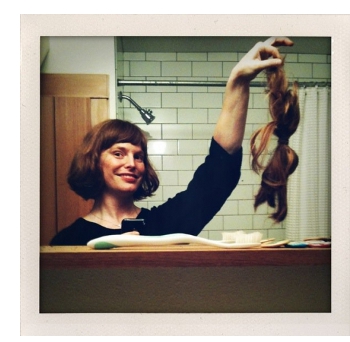 “This was an especially fun book to work on,” Carson added. “The illustrations were done in ink and gouache, a new medium for me. And at the suggestion of Dillweed‘s editor, Sam McFerrin, I hand-lettered every stitch of writing in the book, down to the numbers on the barcode.” The book was eventually awarded a Silver Medal by The Society of Illustrators, Carson’s first illustration award.
“This was an especially fun book to work on,” Carson added. “The illustrations were done in ink and gouache, a new medium for me. And at the suggestion of Dillweed‘s editor, Sam McFerrin, I hand-lettered every stitch of writing in the book, down to the numbers on the barcode.” The book was eventually awarded a Silver Medal by The Society of Illustrators, Carson’s first illustration award.
When I read this one in 2010, I made a mental note to see if Carson would like to stop by for one of my breakfast illustrator interviews. To be sure, she’s illustrated other picture books I’ve enjoyed, and she’s well-known for some of her artwork on both book and album covers. (More on that below.) But it was this delightfully whacked out and macabre tale of Dillweed that really caught my eye. Anyhow. Yes, it’s taken me this long to get to the interview. Sometimes I’m just slow, my friends. And busy. And such.
But this timing works well, despite my delay, as Carson and Colin Meloy, her husband (who just so happens to be the lead singer of The Decemberists, and that’s a note for my fellow music-nerd friends), have just collaborated on a middle-grade novel, Wildwood, set to be released this Fall from Balzer & Bray (HarperCollins). The book has been met with some early positive reviews—a “satisfying blend of fantasy, adventure story, eco-fable and political satire with broad appeal,” writes Kirkus—though I’ve yet to read it myself. And this morning Carson shares lots of artwork and sketches from this, their upcoming illustrated novel.
So, without further ado, let’s get right to it, and I thank her for stopping by to chat. Her breakfast-of-choice this morning is eggs, bacon, fruit, toast, orange juice, and coffee with cream. That, my friends, is a real breakfast, and she took the words right out of my mouth. I’ll set the table, and let’s get the basics from Carson while I do so.
Jules: Are you an illustrator or author/illustrator?
Carson: Just illustrator. I’m working up to the author part.
Jules: Can you list your books-to-date?
Carson: The Mysterious Benedict Society (Trenton Lee Stewart), The Composer Is Dead (Lemony Snicket), The Beautiful Stories of Life (Cynthia Rylant), Stagecoach Sal (Deborah Hopkinson), and Dillweed’s Revenge (Florence Parry Heide).
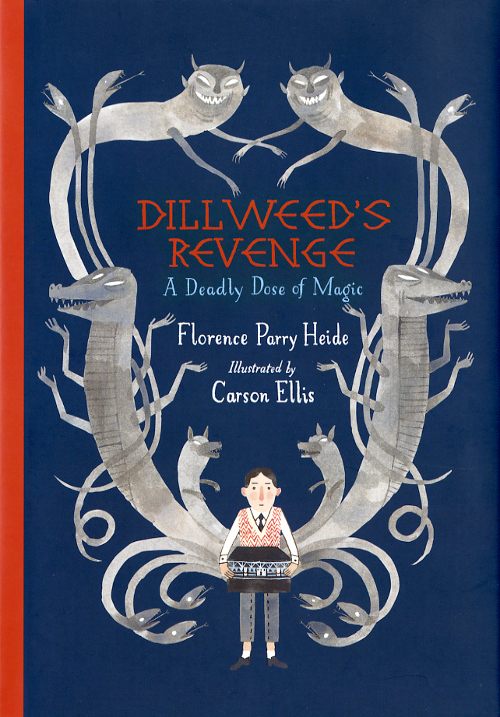
Jules: What is your usual medium, or––if you use a variety—your preferred one?
Carson: I love pen and ink and pencil and gouache equally and in various combinations.
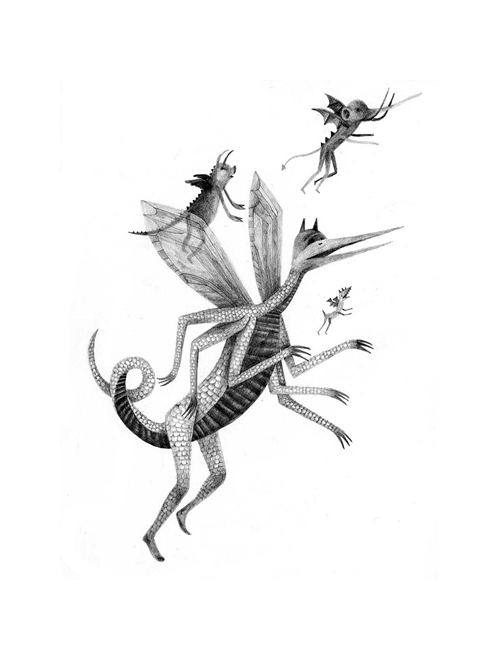
— From Cynthia Rylant’s Beautiful Stories of Life: Six Greek Myths, Retold
(Houghton Mifflin, 2009)
Jules: If you have illustrated for various age ranges (such as, both picture books and early reader books OR, say, picture books and chapter books), can you briefly discuss the differences, if any, in illustrating for one age group to another?
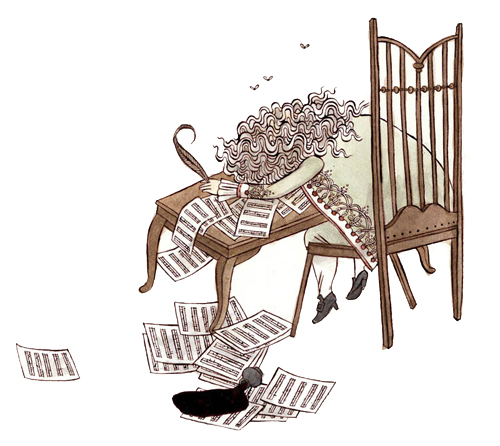
(Click to enlarge)
Carson: I’ve illustrated both picture books and chapter books. They’re so different but, for me, the differences have more to do with the function of the illustration in each than their audience. I think picture books are harder. They need to have a visual arc that matches their story arc. The text and the images are interdependent. Any given page has a relationship to the page that came before and the one that comes after. There’s a craft to it that I think the casual reader might take for granted. The same goes for chapter books, but that process comes a lot more naturally to me. I read until I come to a scene I want to illustrate and then I illustrate it.
Jules: Where are your stompin’ grounds?
Carson: Portland, Oregon.
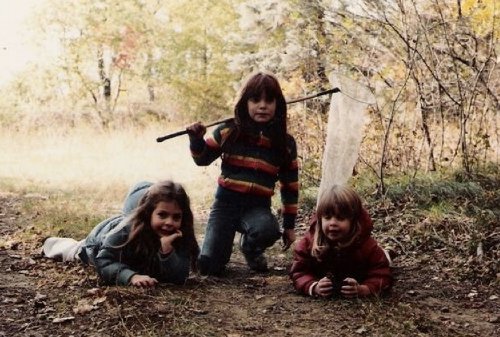
Jules: Can you briefly tell me about your road to publication?
Carson: It began with me as a kid in suburban New York, drawing constantly. As a teenager, I wanted to be an illustrator but, inexplicably, I wanted to go the University of Montana, a school with no illustration classes, more. So, I did.
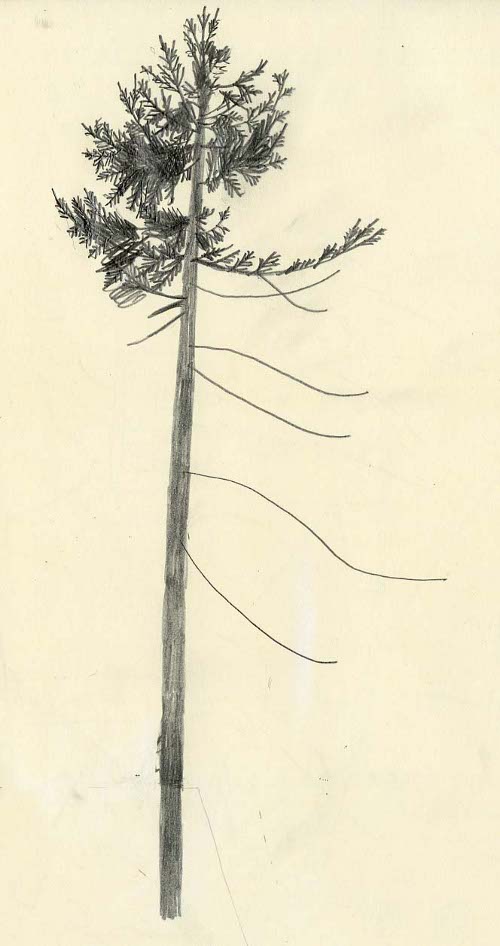
I graduated in 1998 with a painting degree, moved around a lot, was a cocktail waitress in four different states, and eventually settled in Portland, where I was reunited with my good college friend and eventual sweetheart, Colin Meloy. He was starting his band The Decemberists and put me to work doing all sorts of things for them –- flyers, album art, t-shirt designs, website illustrations. They were my first (albeit initially unpaid) illustration gigs. Along with The Decemberists’ stuff, I was having art shows and doing posters for other bands and working as a bartender.

CD booklet/vinyl sleeve illustration for The Hazards of Love by The Decemberists
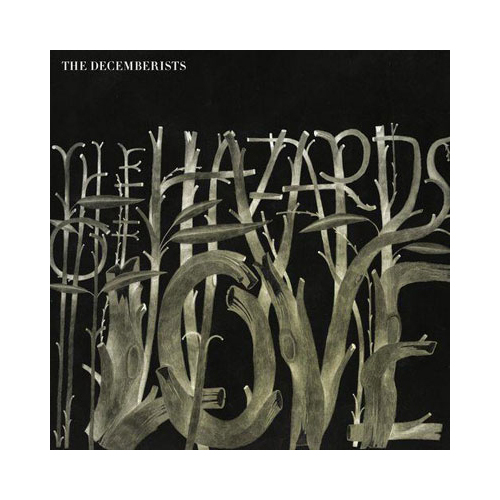

(Illustration for The Decemberists’ website)
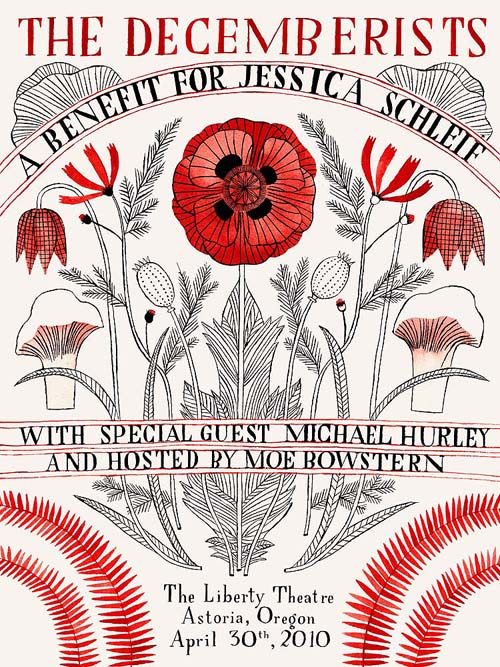
Eventually, art directors, most of whom found me through The Decemberists, started contacting me about editorial work. I didn’t know what “editorial work” meant at the time, and I had to be talked through using Photoshop over the phone by an art director on one of my first jobs. But, after pretending that I knew what I was doing for a while, eventually I sort of did know what I was doing. So, I quit my job at the bar and started calling myself an illustrator. A few years into my new career, Steve Malk, a literary agent, wrote and asked me if I was interested in illustrating books for kids, to which I replied, “Very!” He lined up a bunch of projects for me right off the bat, the first of which was The Mysterious Benedict Society.

Jules: Can you please point readers to your web site and/or blog?
Carson: www.carsonellis.com.
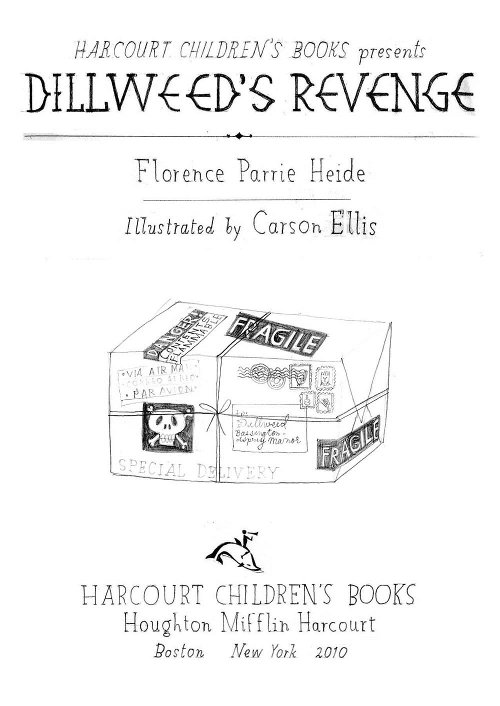
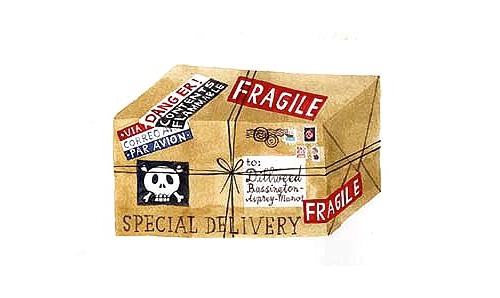
Dillweed’s Revenge: A Deadly Dose of Magic (Harcourt, 2010).
Click each to enlarge and see up close.}
Jules: If you do school visits, tell me what they’re like.
Carson: I do them, though mostly, for some reason, I visit colleges. I show a lot of slides and talk about how I came to do what I do. Two weeks ago, I gave a lecture at Portland State about Wildwood, a novel that Colin wrote and that I just finished illustrating. I showed a lot of images and talked about collaborating with my husband, the editorial process, jacket design (which, in the case of this book, was super challenging — it went through twenty-something revisions, and I showed slides of twenty of them), and other illustration things.

(Illustrator/author photo for Wildwood; Photo credit: Autumn de Wilde)
(Click to enlarge)
(Click to enlarge)
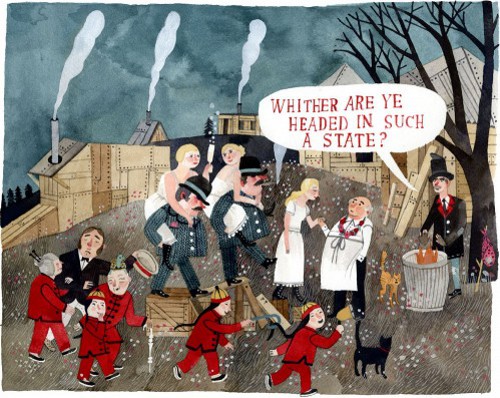
I’ve only visited grade school classrooms a few times, but I know there’s more of that in my future, as I’ll be going on my first proper book tour with Colin for Wildwood, and school visits are a big part of the plan. I’m looking forward to it, but we don’t have our spiel down yet. The one kindergarten classroom I visited was hilarious. I read a book and talked a little bit about drawing, and then I asked if anyone had questions.
Kid: Do you have a cat?
Me: Yes.
Kid: Me, too.
Other kid: Well, I have a purse!
First kid: My mom has two purses!
Another kid: My mom has five million eight zillion purses!
Then, I asked if anyone wanted me to draw them a picture, and every kid said yes. So, I drew twenty pictures and then went home and took a nap.
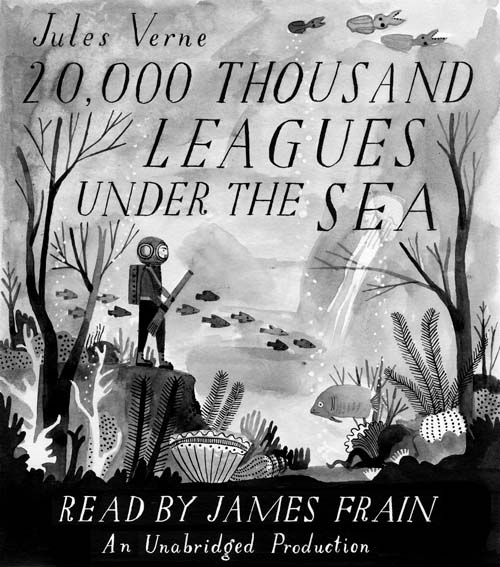
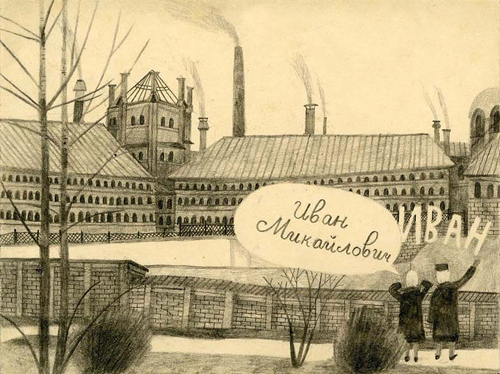
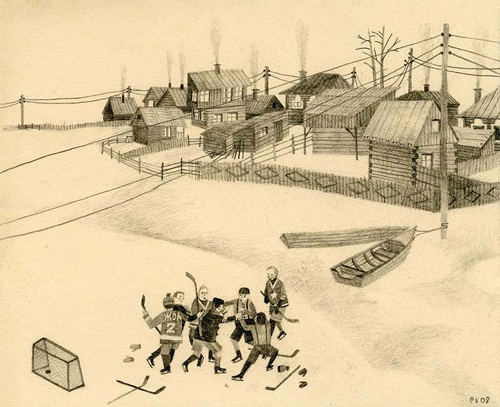
Jules: If you teach illustration, by chance, tell me how that influences your work as an illustrator.
Carson: I don’t teach illustration, but I do teach a free drawing workshop for teenagers at the Portland Art Museum. The class size is limited to ten kids, and they’re all self-motivated artists who are drawing a lot on their own, outside of school. We meet weekly for twelve sessions, and students who are accepted into the workshop are welcome to come back the following year so the group stays together. I love teaching this class. As a teenager, I was an unhappy misfit, and it’s cathartic to be around this group of kids who love to draw and who collaborate with and support each other. It’s also inspiring to see the way they make art, which is always with abandon. They go into the supply closet and come out with armloads of materials they’ve never used before, and they just go for it. I’m so prone to overthinking things when I work, but those kids reminds me that I don’t have to.
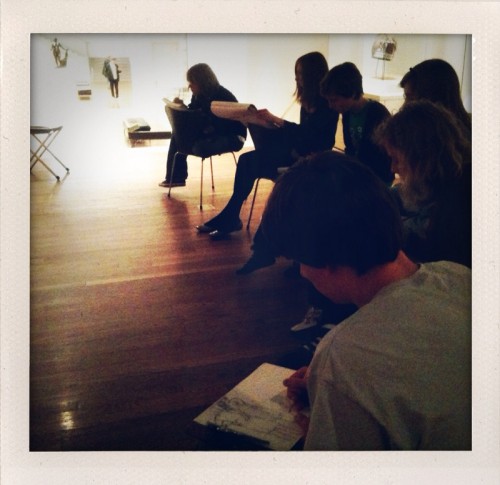
Jules: Any new titles/projects you might be working on now that you can tell me about?
Carson: Like I said, I just finished illustrating Wildwood, a chapter book by my husband. {Sketches and illustrations are below.} It’s set in Portland and in Forest Park, a 5,000-acre swath of woods on the west end of the city. The book features talking animals, dysfunctional governments, battles, bandits, coyote soldiers, mystics, the ruins of an ancient civilization, a deposed forest witch, and more. It also features 85 illustrations! It was my most labor-intensive, all-consuming illustration project to date. Though it’s also the one I’m the most proud of and easily the one closest to my heart.
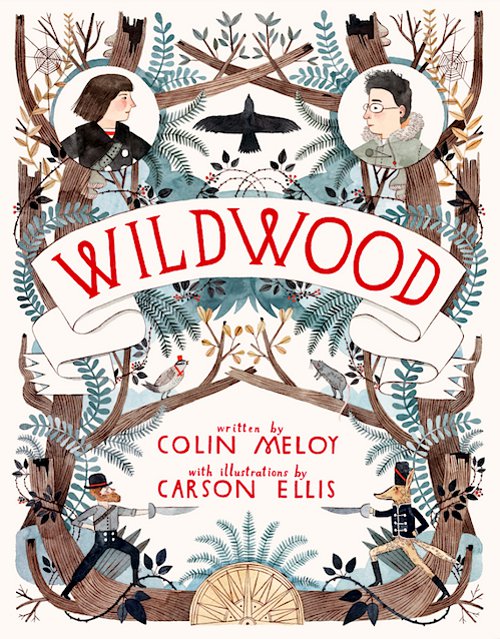
Colin and I have been hoping to collaborate on something like this for the past ten years but, between touring and illustrating and parenting and everything else, we could never seem to make time for it. Last year, at long last, we had a window in our schedules and sat down to work on it. We’re all done now, but it’s the first in a series so we’re already delving into the second book.
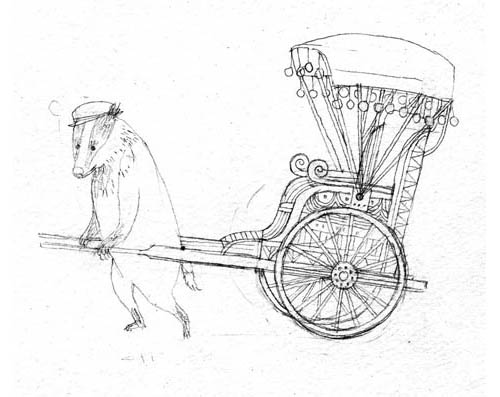

from Wildwood, 2011, gouache and ink


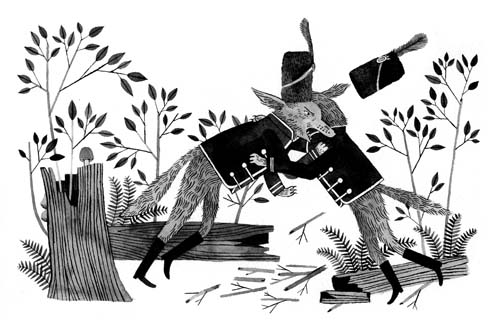
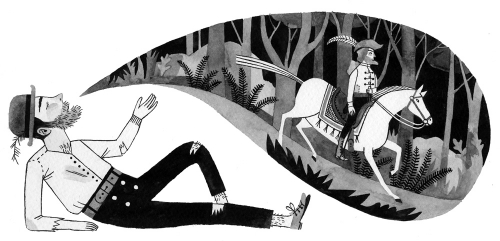

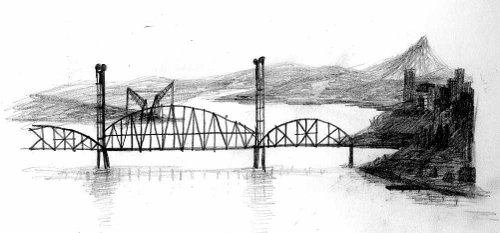


 Coffee’s on, and our table’s set now for our breakfast interview. Let’s get a bit more detailed, and I thank Carson again for stopping by.
Coffee’s on, and our table’s set now for our breakfast interview. Let’s get a bit more detailed, and I thank Carson again for stopping by.
1. Jules: What exactly is your process when you are illustrating a book? You can start wherever you’d like when answering: getting initial ideas, starting to illustrate, or even what it’s like under deadline, etc. Do you outline a great deal of the book before you illustrate or just let your muse lead you on and see where you end up?
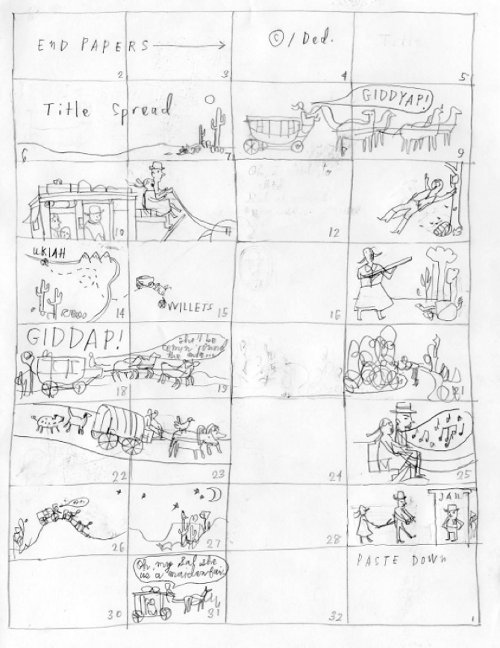
Carson: I think I’m still figuring it out. Each book has been different. Picture books have typically started with a very rough storyboard. All books involve overly meticulous sketching. I work slowly and painstakingly, even on sketches. All books also involve a lot of reference-seeking. I spend time looking through art books, photo books, children’s books, gardening books, wildlife books. And I spend a stupid amount of time searching for source images online. I get especially lost in the New York Public Library digital archive. And Google image search is my ruination.
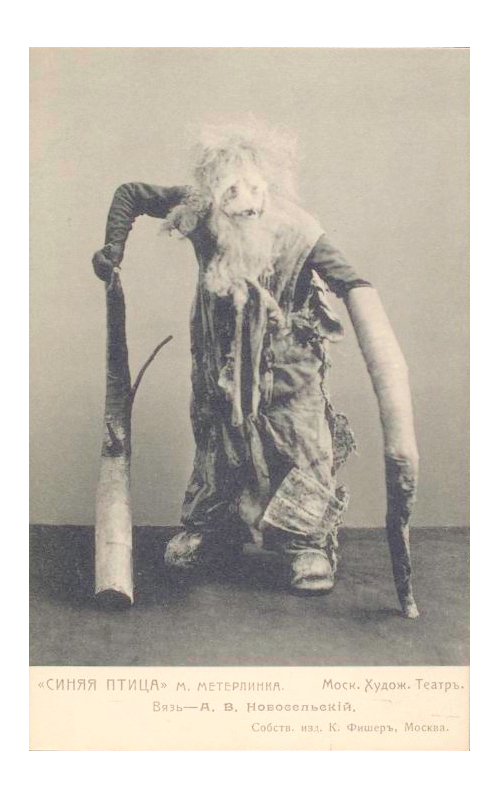
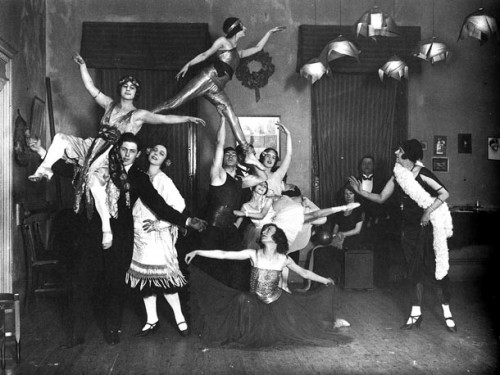
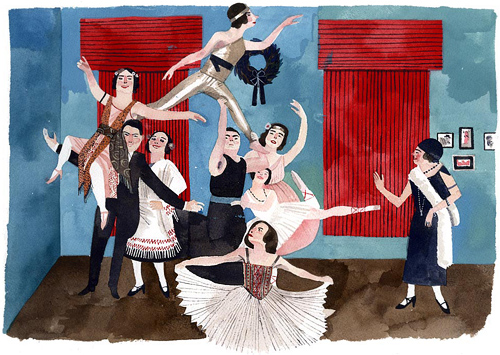
For Wildwood, I had so much to do in such a short amount of time, so I didn’t really do any rough sketching, which was interesting. Each of the interior illustrations was drawn for the first time in pencil on watercolor paper. Most of them were approved as is or just needed a little tweaking (thanks to my benevolent editor), and then I inked and painted them. Because I wanted to figure out where blacks and greys would go, but I also wanted to keep the sketch pristine, I would scan it, print it out on cardstock, put a wash over the printout of the sketch, scan the printout, combine the printout with the original sketch digitally, and send that to my editor. Then, once approved, I’d go back to the sketch and ink and paint it. I was proud of this solution. My computer skills are limited, and this actually made me feel tech-savvy, plus I think it saved a lot of time. Being rushed through making art is what I like least about my job, but this was a compromise. I had a little extra time to labor over the sketches, because I was only doing them once.
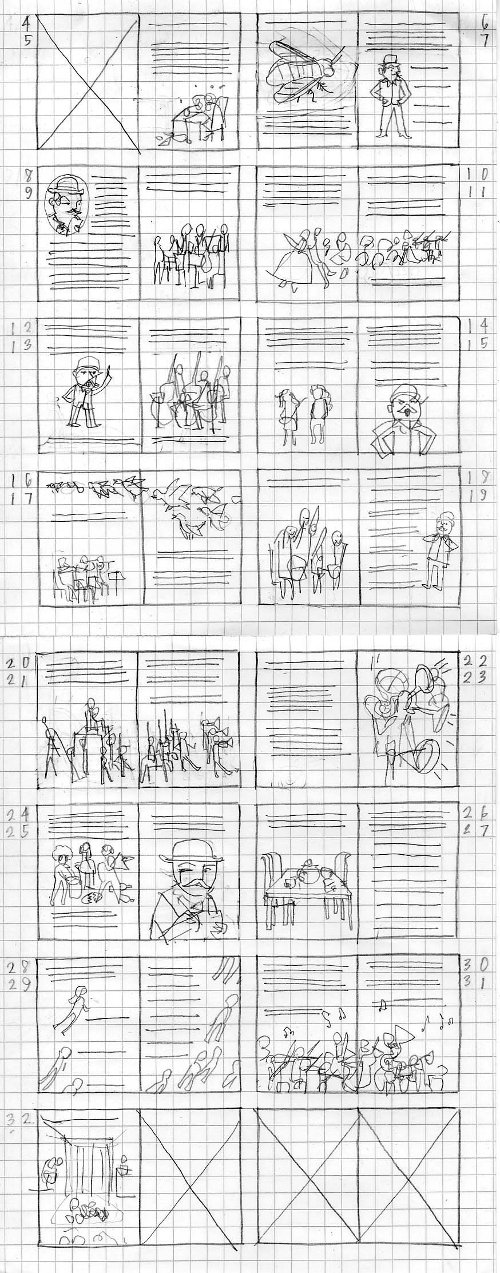
As for writing a book, lately I’ve been thinking more about that -– about making a picture book. I haven’t done a lot of writing over the past five years or so, but I’m trying to do more. Right now I have a Word file that I guess is sort of a journal of ideas. I’m always adding to it, though, so far most of what’s there—a brief history of my neighborhood, a depressing poem about fog, a gardening journal, doomsday earthquake fantasies—would make for a sorry picture book. But, through it all, an idea is slowly taking shape and, along with it, illustrations. It’s just the germ of an idea but it feels exciting.
2. Jules: Describe your studio or usual work space.
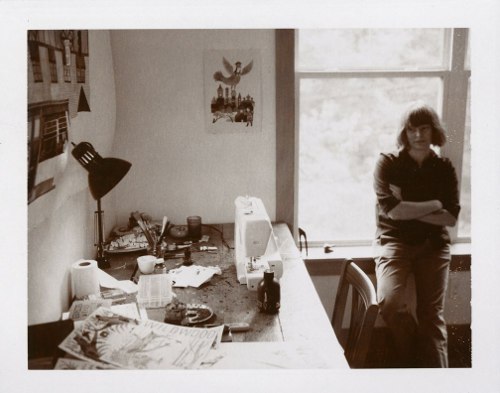
Carson: My studio is in the upstairs of our converted garage. It’s a bright, pretty, treehouse-like room with skylights and a big picture window. I heat it with a pellet stove, and it’s very snug during Oregon’s wet, misty months. In the summer, I open up the door and the windows, and breezes blow through all day. It’s one of my favorite places in the world. I’ve had a motley assortment of studios in my life—closets, unheated warehouses, often just the bedroom I was renting in whatever house—and this one is my Shangri-la. I work at a big wooden table that I built myself, and I sit on one of those funny ergonomic kneeling chairs that were all the rage when I was a kid in the ’80s.
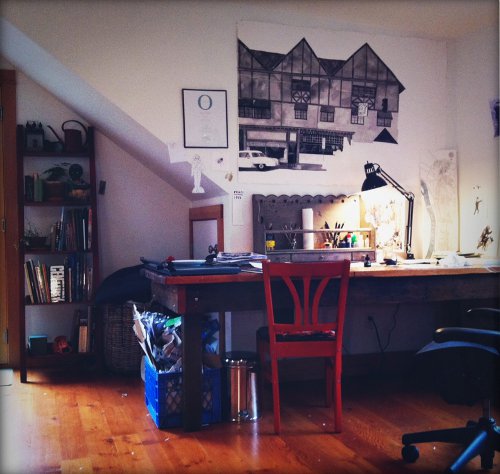
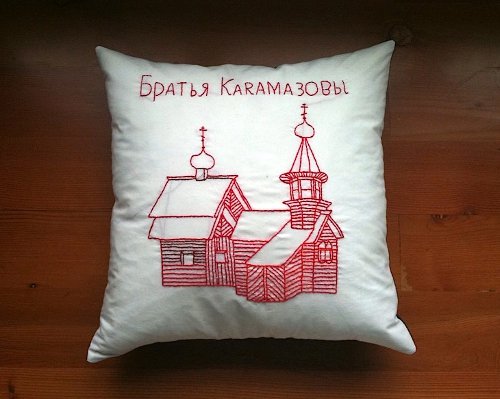
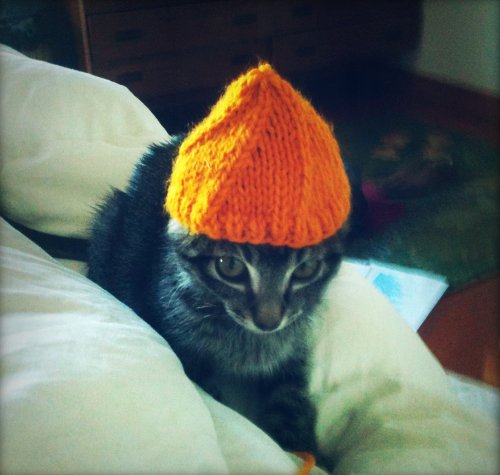
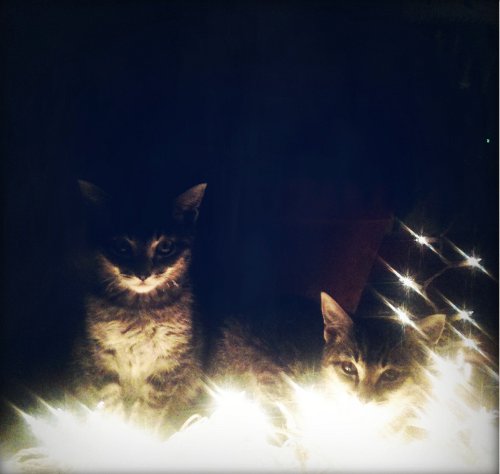
3. Jules: As a book lover, it interests me: What books or authors and/or illustrators influenced you as an early reader?
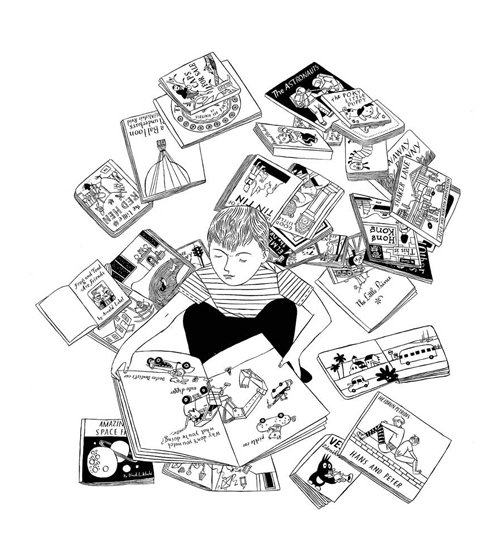
Carson: Overwhelmingly, The Chronicles of Narnia. I read all seven of those books again and again. Their illustrator, Pauline Baynes, has probably influenced me more as an artist than anyone else. I also loved The Hobbit, Alice in Wonderland, The Phantom Tollboth, the Madeleine L’Engle books, and a picture book called Hugo and Oddsock, which is stuck in my memory in the weirdest, most indelible way, though I don’t even own a copy of it as an adult. It’s hard for me to remember the books I loved as a kid—I have a bad memory—but sometimes in a bookstore or library I’ll catch sight of one that I’d forgot about and haven’t seen in 25 or 30 years, and it will actually make me weak in the knees.
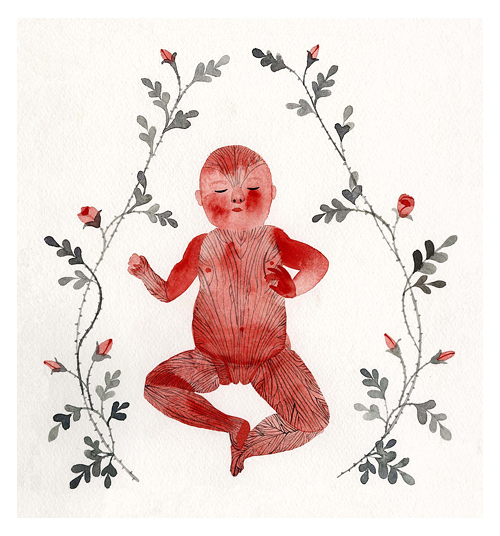
in which the assignment was to illustrate a passage from
Raymond Roussel’s surrealist poem, Locus Solus)

As for early influential illustrators, none really come to mind. As a teenager, I fell in love with Maurice Sendak’s work and dug all of his books out of the basement where they’d been since my sister and I outgrew them. Around the same time, I became interested in Aubrey Beardsley and Arthur Rackham. But I don’t recall noticing illustration that much when I was a little kid. I think I was just absorbing it. Pauline Baynes was such a big influence on me, because my obsession with Narnia really caused me to pore over those illustrations until I knew their every detail by heart. I think she did such a beautiful, classy, heartfelt job on those books, and I’m still really moved by the illustrations. I wish more people knew her name.
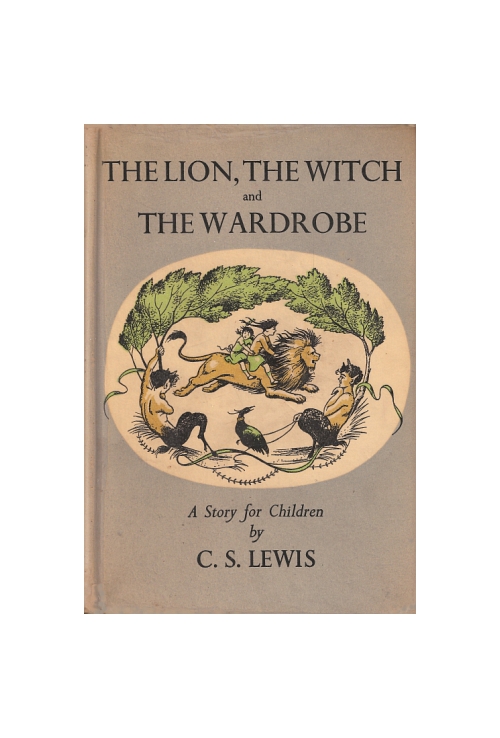
4. Jules: If you could have three (living) illustrators—whom you have not yet met—over for coffee or a glass of rich, red wine, whom would you choose?
Carson: Easy: Alice Provensen, Tomi Ungerer, and Maurice Sendak.
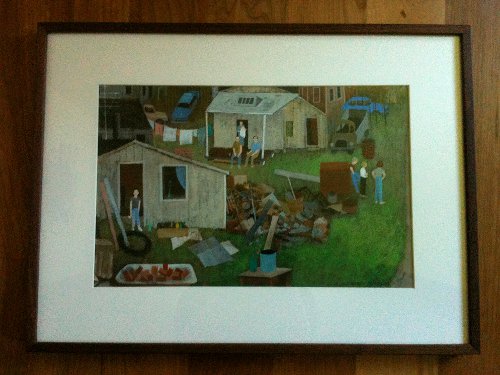
pretty much my most cherised belonging.”
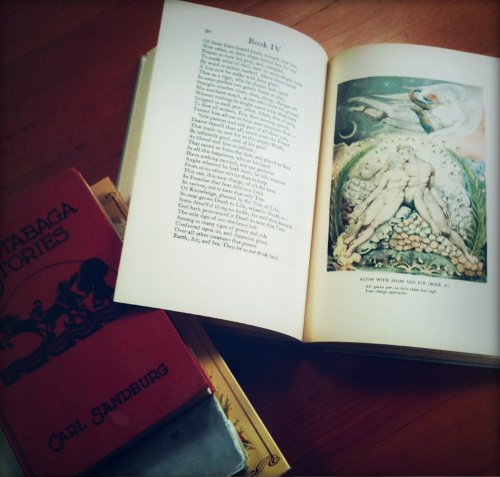
5. Jules: What is currently in rotation on your iPod or loaded in your CD player? Do you listen to music while you create books?
Carson: I’m always listening to music. I like folk music -– Michael Hurley, Neil Young, Bert Jansch, Karen Dalton, and Sybille Baier are some of my favorites. I love to listen to gospel when I’m drawing -– I have a Staple Singers record that I’ve probably listened to a thousand times, and I have an exhaustive gospel compilation called Fire In My Bones that I also listen to a lot. I love The Grateful Dead. Yet, I also love rap. Nary a day goes by that I don’t listen to Kanye. Right now “Whokill” by tUnE-YaRdS is on heavy rotation in my studio. I listened to it three times in a row today. It’s so good!
{Below are sketches and one final illustration from Deborah Hopkinson’s Stagecoach Sal (Hyperion, 2009).}
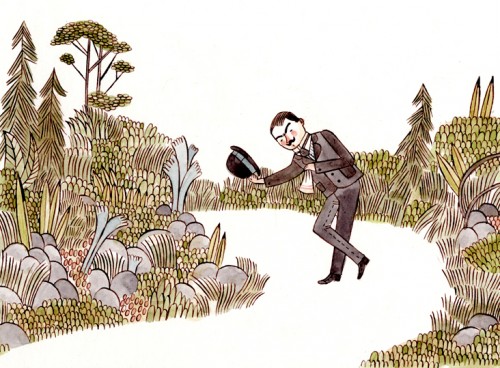
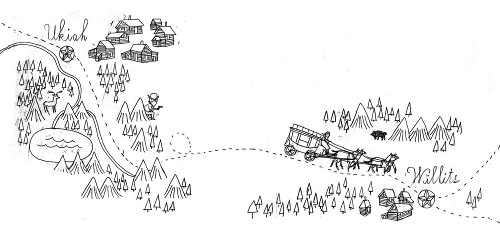
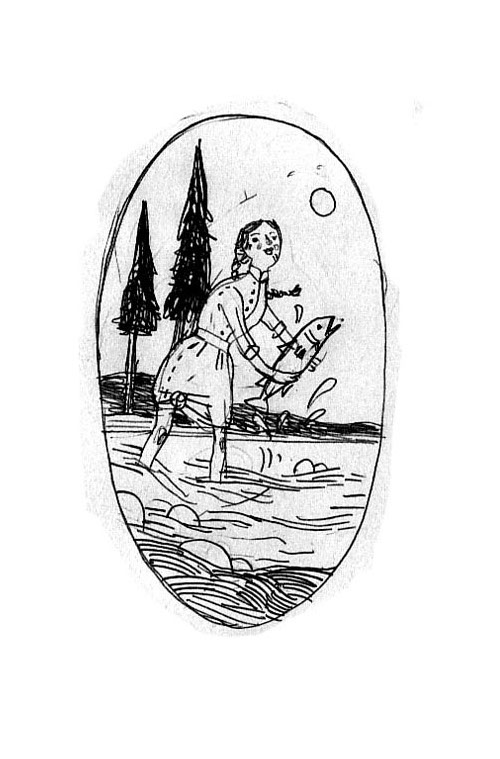
6. Jules: What’s one thing that most people don’t know about you?
Carson: Maybe that I’m Jewish? I have an Anglo surname, and people always say I don’t look Jewish, because I’m a redhead but, come to find out, before the twentieth century red hair was often associated with Jewishness in Europe. I learned this recently, because my friend Joan sent me a link to the Wikipedia entry on Red Hair, which was really interesting. I also found out that redheads have a higher threshold for pain, unless it’s pain caused by a burn, in which case we have a lower threshold (two more things most people don’t know about me).

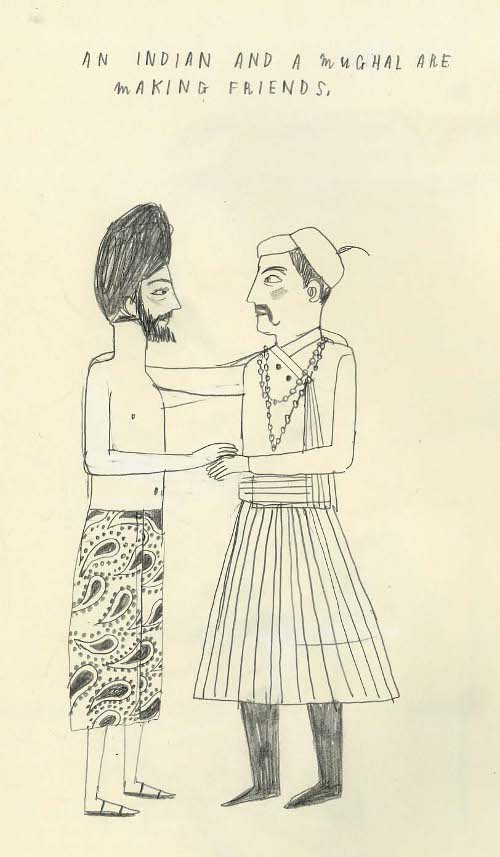
7. Jules: Is there something you wish interviewers would ask you — but never do? Feel free to ask and respond here.
Carson: “Would you like to do an artist’s residency in Siberia?”
Yes, I would.
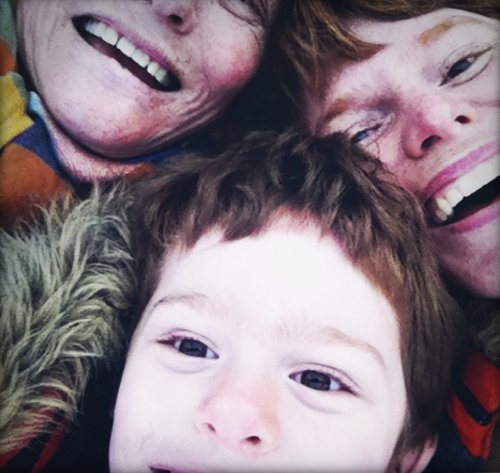

Jules: What is your favorite word?
Carson: “Dude.”
Jules: What is your least favorite word?
Carson: “Dude.”
Jules: What turns you on creatively, spiritually or emotionally?
Carson: Growing plants, walking in the woods.
Jules: What turns you off?
Carson: Meticulous landscaping.
Jules: What sound or noise do you love?
Carson: Rain on my roof, bullfrogs, windchimes, mourning doves.
Jules: What sound or noise do you hate?
Carson: Lawnmowers.
Jules: What profession other than your own would you like to attempt?
Carson: Gardener.
Jules: What profession would you not like to do?
Carson: Cocktail waitress. Never again.
Jules: If Heaven exists, what would you like to hear God say when you arrive at the Pearly Gates?
Carson: “Dude!”
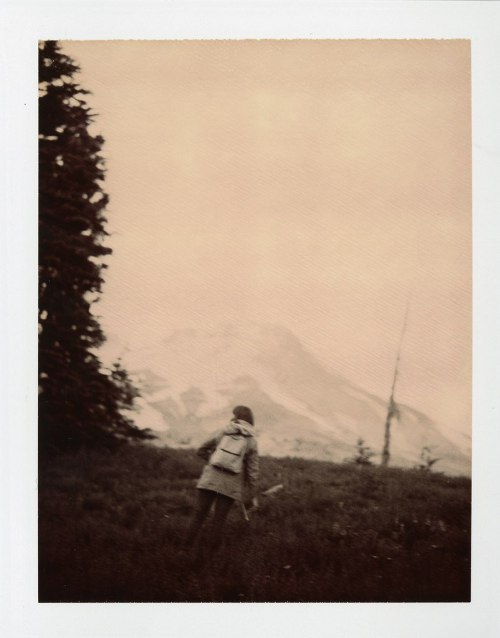
All artwork and images used with permission of Carson Ellis. All rights reserved.
Photo credit for black and white image of Carson and Colin, as well as the sepia photos: Autumn de Wilde.
The spiffy and slightly sinister gentleman introducing the Pivot Questionnaire is Alfred, © 2009 Matt Phelan. Thanks to Matt, Alfred now lives permanently at 7-Imp and is always waiting to throw the Pivot Questionnaire at folks.

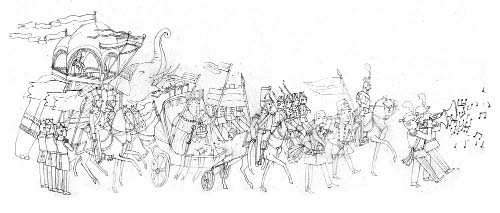

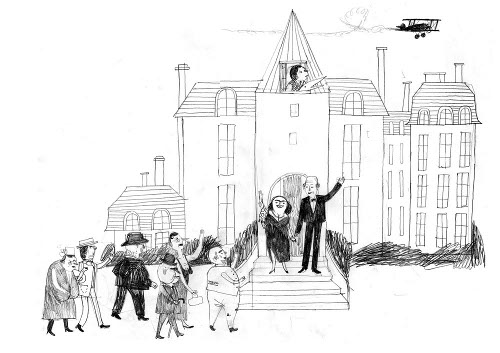
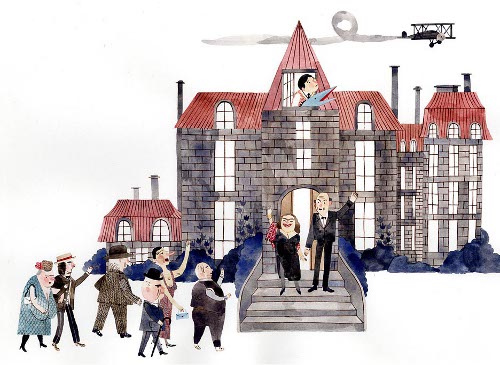
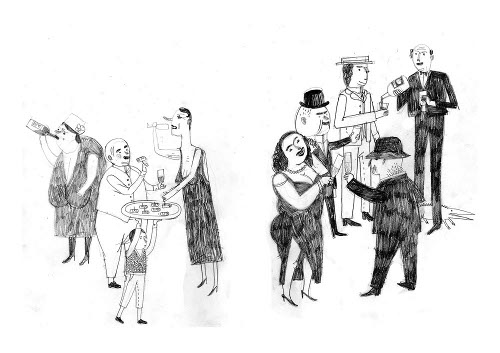
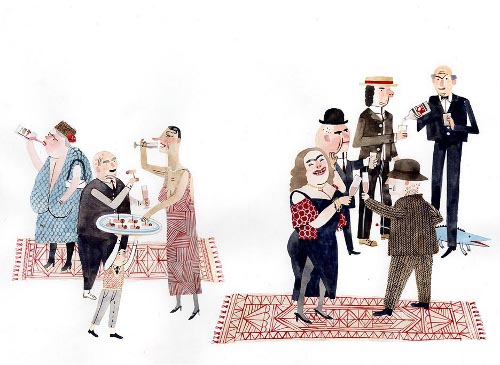

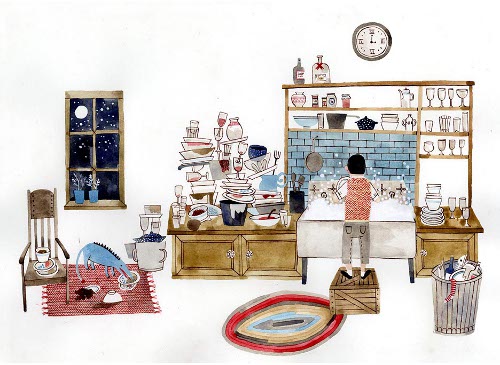

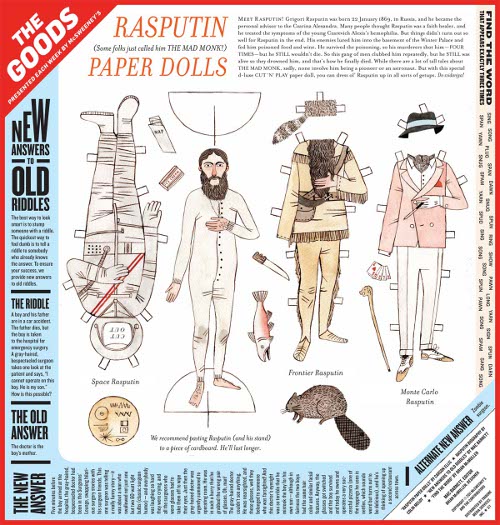
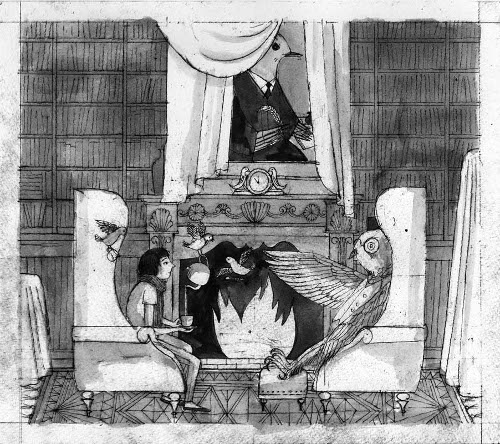

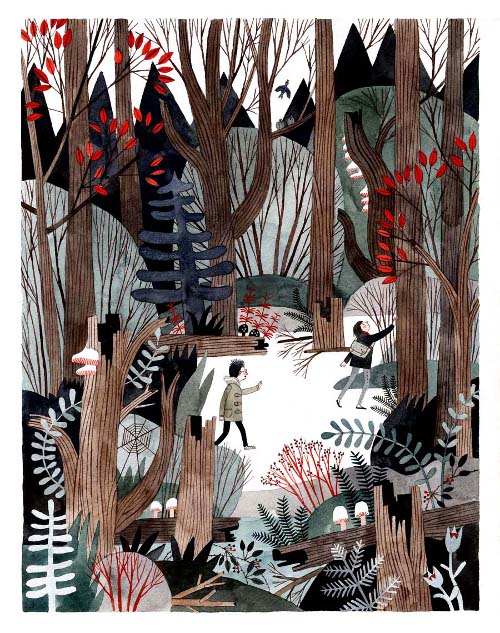
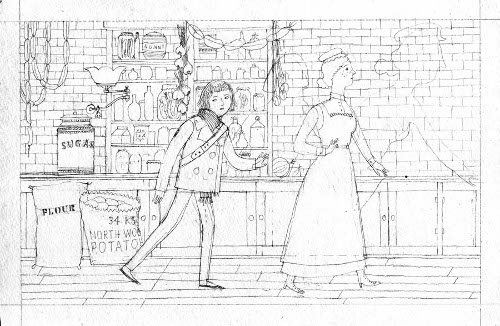
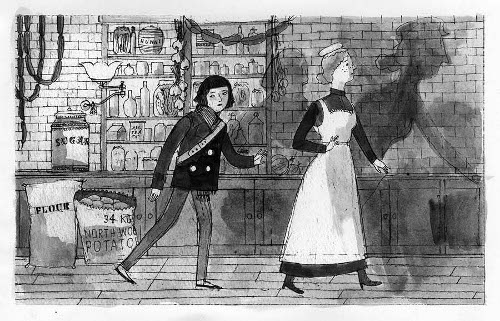

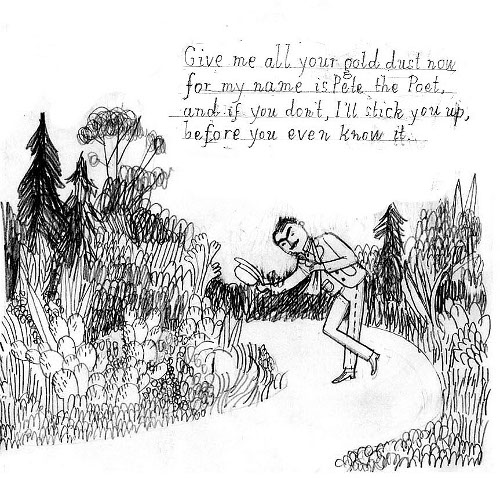

Oh, this was really fun – the details of the rickshaw, the musical notes, the gouache — SIGH!!!
Lovely, lovely stuff. And I LOVE that Decemberist album cover – gorgeous and slightly eerie.
Carson, this is fabulous! I love all the drawings. Loved Dillweed’s Revenge. Favorite’s are: That spare pine tree, the the baby with the crows, and Rasputin paper dolls!!??? (Why didn’t I think of that.) There is a thread of genius in that.
Jules, for some reason this is one of my favorites interviews! Thanks.
amy
Carson Ellis is just brilliant!! Love her work and her story. Julie, thank you so much for this and all your interviews.
this an absolutely lovely interview, thank you so much both!
Fantastic interview! Love her style, and it’s so interesting to hear about her process and how she came to do this beautiful work!
Gosh, I’d like to meet Carson someday. Great , great interview, (Jules, I’d like to meet you too.)
Oh man, you never tell the kids you will draw them all pictures. You tell them you’ll draw one big picture they can see every day in the library, which satisfies NO ONE.
Wildwood is really great. I’m looking forward to rereading it with all the illustrations in place.
Fantastic. Can’t wait to pick up a copy of Wildwood. Great interview, Jules!
Wow, wow, wow. This is all so fantastic…I’m in awe.
Lovely work–looking forward to the book! Noticed the Rutabaga Stories with the Petersham illustrations in Carson’s stack. Also WONDERFUL stuff. In my teens I had a friend silkscreen the Potato-faced Blind Man on a t-shirt for me. Still have it somewhere…
Wowwwwww! I’m so happy you interviewed Carson, I LOVE her work. Thank you for the inspiration and sharing Jules!
Dillweed looks like my kind of book. How have I missed it?
LOVE Carson’s work….loved this interview. Thanks Jules!
She is among the very best.
[…] 1) Speaking of Oscar Wilde, I stumbled last weekend upon this wonderful image from Autumn de Wilde while working on Carson Ellis’s interview. […]
Many years ago I was an Arts & Crafts Instructor at a summer camp, Carson was one of my campers. I am so proud of her achievements and so thrilled to see that she has become a fantastic illustrator (big smile). Julie this is a wonderful interview.
Inspiring work. Thanks for painting it, dude!
I’m with Julie P, above… Truly inspiring, solid work. I’m so glad (for all our sake) you’re not having to wait tables and tend bar anymore, although I’m sure you were pretty good at that, too. Cheers.
i love your work, I bought Wildwood, i´m waiting for it!!!!
Great, terrific, great!!!
[…] an interview with her at Seven Impossible Things before Breakfast, Design*Sponge & The Huffington Post. Below, a lovely piece of animation for the book she […]
[…] much more on Ellis’s website! Also: Jules Walker Danielson did a great (and lavishly illustrated) interview with Ellis over on Seven Impossible Things Before Breakfast. Indeed, if you care about children’s […]
Perfect just what I was looking for! . 411131
[…] in October. I am fairly certain his talented illustrator wife, Carson Ellis (who visited 7-Imp here last year), will also be speaking. I hope so. I’ll be moderating their panel discussion, I […]
[…] [Note: The above photo was taken from my 2011 interview with Carson.] […]
Hey guys! In case anyone is looking for the Game of Thrones Season 3 Premiere here is a working link! http://bit.ly/13JcQHt
[…] Here’s my 2011 breakfast interview with her. […]
I’m a huge Carson Ellis fan and loved this interview. Also, this is one of my favorite blogs. Thanks for all the good reading!
[…] and would not be the same without her illustrative genius. I am really relishing each chapter. This is a fun interview with Carson, if you interested in probing further and seeing more of her fine […]
[…] I’ve got a review over at BookPage of Carson Ellis’s newest picture book, Du Iz Tak? (Candlewick, October […]
[…] most I have been lucky enough to meet. (So I can leave out Jon Klassen, Laurie Keller, Loren Long, Carson Ellis, Lane Smith, Jillian Tamaki, Ted and Betsy Lewin, among many others.) But even still, this is crazy […]
[…] so many favorites — Lisbeth Zwerger, Isabelle Arsenault, Marc Simont, Suzy Lee, Komako Sakai, Carson Ellis, Jon Klassen, Beatrice Alemagna, Edward Gorey, Shel Silverstein, David Roberts, Quentin Blake, […]